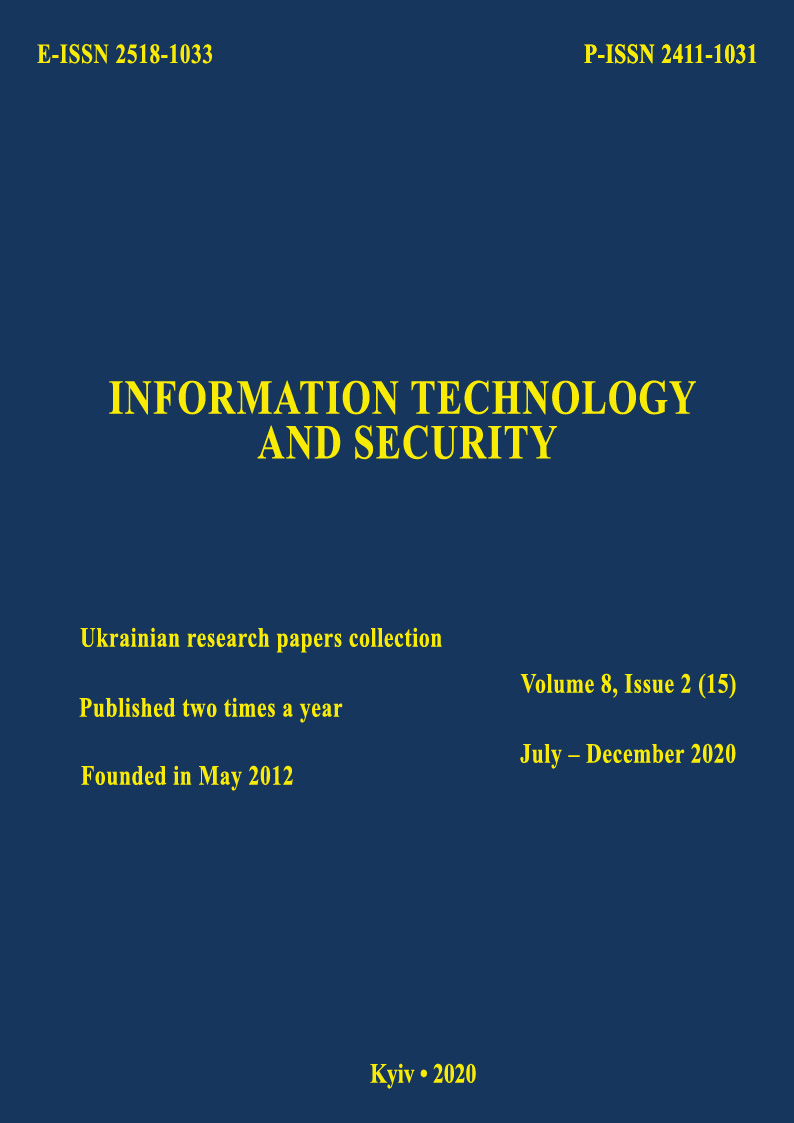Volume increasing of secret message in a fixed graphical stego container based on intelligent image analysis
DOI:
https://doi.org/10.20535/2411-1031.2020.8.2.222589Keywords:
steganography, container, image, edge detection, cellular automata, secret messageAbstract
The paper considers methods of edge pixel selection based on Roberts, Previtt, and Sobel operators, as well as technologies of cellular automata to increase the volume of the implemented secret message. Based on the methods used, templates with selected pixels were formed, into the codes of which secret message bits were embedded. The templates were formed using threshold additional processing, which allowed to select the optimal threshold for the selection of the corresponding pixels of the image of the container. Thresholds ranging from 100 to 300 were selected for the Roberts operator, and thresholds ranging from 1,000,000 to 15,000,000 were selected for the Previtt and Sobel operator. To select pixels based on cell technology, four cell neighborhood shapes were used for binary and color imaging. Experimental studies were performed for all methods of pixel selection, which made it possible to determine the optimal numerical threshold, as well as the number of lower bits of each selected pixel to implement the bits of the secret message. It has been experimentally established that for all methods, except for the two lower bits of the code of each pixel, the bits of the secret message are also embedded in the four lower bits of each byte of code of the selected pixel, which significantly increases the volume of the embedded message. When using two lower bits of all pixels and four lower bits of selected pixels for many templates, no change in the visual images of the containers was observed. Using the fifth lower bit in each byte of the selected pixel code to enter the secret bit results in significant distortion of the visual picture. The experiments were performed for different brightness thresholds during binarization. In total, six additional secret bits were added to the code of each selected pixel. For the efficiency of the experiments, bit sequences containing only one zero, one unit, and randomly generated bit sequences were introduced into the containers.
References
H. Sajedi, Recent Advances in Steganography. London: November 07, 2012, doi: http://dx.doi.org/10.5772/2501.
G. Kipper. Investigator’s Guide to Steganography. Boca Raton: Auerbach Publications, 2003.
E. Cole. Hiding in Plain Sight: Steganography and the Art of Covert Communication. Hoboken: Wiley, 2003.
A. Yahya, Steganography Techniques for Digital Images. Cham: Springer, 2019, doi: https://doi.org/10.1007/978-3-319-78597-4.
M. Bilan, and A. Bilan, “Research of Methods of Steganographic Protection of Audio Information Based on Video Containers”. Handbook of Research on Intelligent Data Processing and Information Security Systems. Edited by Bilan, S. M., & Al-Zoubi, S. I. Hershey: IGI Global, pp. 79-94, 2019.
M. Saracevic, A. Selimi, and S. Pepić, “Implementation of Encryption and Data Hiding in E-Health Application” Handbook of Research on Intelligent Data Processing and Information Security Systems. Edited by Bilan, S. M., & Al-Zoubi, S. I. Hershey: IGI Global, pp. 25-42, 2019.
G. Blokdyk, Steganography. 5STARCooks, 2019.
N. Albdour, and N. Zanoon, “A Steganographic Method Based on Roberts Operator”, Jordan Journal of Electrical Engineering, vol. 6, iss. 3, pp. 265-273, 2020.
N. Albdour, “Selection image points method for steganography protection of information”, WSEAS Transactions on Signal Processing, vol. 14, pp. 151-159, 2018.
S. Bilan, and O. Kolochun, “Method of steganographic concealing information based on modified containers”, Collection of scientific work of the State economic and technological university of transport, vol. 25, pp. 107-113, 2014.
L. Roberts, “Machine Perception of Three-Dimensional Solids”, Optical and ElectroOptical Information Processing. Cambridge: MIT Press, pp. 159-197, 1965.
J. M. S. Prewitt, “Object Enhancement and Extraction”, Picture processing and Psychopictorics. Academic Press, 1970.
J. M. S. Prewitt, and M. L. Mendelsohn, “The Analysis of Cell Images”, Ann. N.Y. Acad. Sci., vol. 128, pp. 1035-1053, 1966, doi: https://doi.org/10.1111/j.1749-6632.1965.tb11715.x.
I. E. Sobel, Camera Models and Machine Perception, PhD Thesis, Stanford Univ, 1970.
S. Bilan, Formation Methods, Models, and Hardware Implementation of Pseudorandom Number Generators: Emerging Research and Opportunities. Hershey: IGI Global, 2017.
S. Bilan. “Models and hardware implementation of methods of Pre-processing Images based on the Cellular Automata”, Advances in Image and Video Processing, vol. 2, iss. 5, pp. 76-90, 2014, doi: https://doi.org/10.14738/aivp.25.561.
Downloads
Published
How to Cite
Issue
Section
License
Copyright (c) 2020 Information Technology and Security

This work is licensed under a Creative Commons Attribution 4.0 International License.
The authors that are published in this collection, agree to the following terms:
- The authors reserve the right to authorship of their work and pass the collection right of first publication this work is licensed under the Creative Commons Attribution License, which allows others to freely distribute the published work with the obligatory reference to the authors of the original work and the first publication of the work in this collection.
- The authors have the right to conclude an agreement on exclusive distribution of the work in the form in which it was published this anthology (for example, to place the work in a digital repository institution or to publish in the structure of the monograph), provided that references to the first publication of the work in this collection.
- Policy of the journal allows and encourages the placement of authors on the Internet (for example, in storage facilities or on personal web sites) the manuscript of the work, prior to the submission of the manuscript to the editor, and during its editorial processing, as it contributes to productive scientific discussion and positive effect on the efficiency and dynamics of citations of published work (see The Effect of Open Access).

